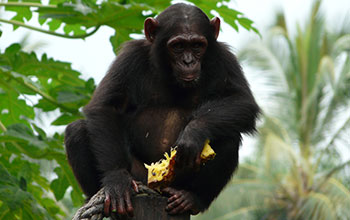Multimedia Gallery
Ngambe, a Nigeria-Cameroon chimp rescued from illegal animal trafficking
Ngambe, a Nigeria-Cameroon chimp rescued from illegal animal trafficking who now lives at the Limbe Wildlife Center in Cameroon.
More about this image
Recent research by a team from Drexel University and supported by the National Science Foundation (NSF) revealed new insights about the Nigeria-Cameroon chimpanzee (Pan troglodytes ellioti), including their population genetics, evolutionary history and habitat ecology.
Cameroon is the only country where the ranges of two chimpanzee subspecies converge, making it an ideal location to study the factors that create and maintain genetic diversity among populations.
Initially the researchers sought to understand the biogeographic barriers separating the Nigeria-Cameroon chimps from their neighbors to the south, the Central African chimpanzees. But findings from the study are much more complex.
For example, the team found that Cameroon chimps likely speciated as a result of natural selection, and not simply due to geographic isolation across the Sanaga River as previously thought. They also found evidence of an additional distinct gene pool of Nigeria-Cameroon chimps in the savanna-woodland mosaic of central Cameroon. This savanna-woodland habitat is very different from the wet rainforest habitats occupied in western and southern Cameroon, suggesting the possibility that chimps in Cameroon and Nigeria adapted to their habitats and that is what has driven their speciation.
With this in mind, the researchers theorized if the chimps really were adapted to their habitats, then it would be expected that each population would occupy divergent niches within an ecosystem. The team collected environmental data from satellite imagery, then modeled the suitable habitat of each population of chimps and found that indeed this was the case.
Research by the team has also shown that habitat variation is much more important in shaping genetic diversity in Nigeria-Cameroon chimpanzees living in both the rainforest and the savanna-woodland mosaic than it is for Central African chimpanzees.
The researchers wondered: If environmental variation and differences in habitat have shaped these populations over time, then how might climate change alter their suitable habitat in the future? After projecting models for each chimpanzee population under climate scenarios through to the end of this century, they determined that the chimp's habitat would likely deteriorate in the near future. The Nigeria-Cameroon chimps living in the savanna-woodland mosaic habitat in central Cameroon are under the most immediate threat of climate change, and may completely lose their habitat within our lifetime.
These findings are very important for the conservation of the Nigeria-Cameroon chimps. West-Central Africa is currently undergoing rapid economic growth and chimps in this region are already under constant threat from habitat loss from industrialized agriculture, illegal hunting and wildlife trafficking. Comprehensive and proactive conservation planning is therefore key to ensuring their survival.
[Text used by permission from the blog "What can chimpanzee tracking tell you about climate change?" by Paul Sesink Clee. Sesink Clee was part of the Drexel team that conducted this research and is currently a Ph.D. candidate at the university studying disease ecology and climate change in wildlife across equatorial Africa.]
[Research supported by NSF grants BCS 0755823 and OISE 1243524.]
To learn more, see the NSF News From the Field story Most endangered chimpanzees have complex evolutionary past, perilous future. (Date image taken: 2014; date originally posted to NSF Multimedia Gallery: Dec. 16, 2015)
Credit: Paul Sesink Clee
See other images like this on your iPhone or iPad download NSF Science Zone on the Apple App Store.
Images and other media in the National Science Foundation Multimedia Gallery are available for use in print and electronic material by NSF employees, members of the media, university staff, teachers and the general public. All media in the gallery are intended for personal, educational and nonprofit/non-commercial use only.
Images credited to the National Science Foundation, a federal agency, are in the public domain. The images were created by employees of the United States Government as part of their official duties or prepared by contractors as "works for hire" for NSF. You may freely use NSF-credited images and, at your discretion, credit NSF with a "Courtesy: National Science Foundation" notation.
Additional information about general usage can be found in Conditions.
Also Available:
Download the high-resolution JPG version of the image. (4.2 MB)
Use your mouse to right-click (Mac users may need to Ctrl-click) the link above and choose the option that will save the file or target to your computer.

 All images in this series
All images in this series